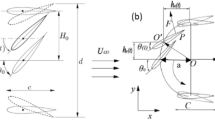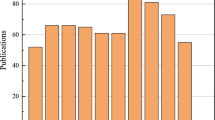Abstract
Unlike birds, insects lack control surfaces at the tail and hence most insects modify their wing kinematics to produce control forces or moments while flapping their wings. Change of the flapping angle range is one of the ways to modify wing kinematics, resulting in relocation of the mean Aerodynamic force Center (mean AC) and finally creating control moments. In an attempt to mimic this feature, we developed a flapping-wing system that generates a desired pitching moment during flapping- wing motion. The system comprises a flapping mechanism that creates a large and symmetric flapping motion in a pair of wings, a flapping angle change mechanism that modifies the flapping angle range, artificial wings, and a power source. From the measured wing kinematics, we have found that the flapping-wing system can properly modify the flapping angle ranges. The measured pitching moments show that the flapping-wing system generates a pitching moment in a desired direction by shifting the flapping angle range. We also demonstrated that the system can in practice change the longitudinal attitude by generating a nonzero pitching moment.
Similar content being viewed by others
References
Weis-Fogh T. Quick estimates of flight fitness in hovering animals, including novel mechanisms for lift production. Journal of Experimental Biology, 1973, 59, 169–230.
Ellington C P. The aerodynamics of hovering flight. I V. Aerodynamic mechanisms. Philosophical Transactions of Royal Society B, 1984, 305, 79–113.
Dickinson M H, Gotz K G. Unsteady aerodynamic performance of model wings at low Reynolds numbers. Journal of Experimental Biology, 1993,174, 45–64.
Dickinson M H. The effects of wing rotation on unsteady aerodynamic performance at low Reynolds numbers. Journal of Experimental Biology, 1994, 192, 179–206.
Dickinson M H, Lehmann F, Sane S P. Wing rotation and the aerodynamic basis of insect flight. Science, 1999, 284, 1954–1960.
Taylor G K, Thomas A L R. Animal flight dynamics II. Longitudinal stability in flapping flight. Journal of Theoretical Biology, 2002, 214, 351–370.
Hedrick T L, Daniel T L. Flight control in the hawkmoth Manduca sexta: The inverse problem of hovering. Journal of Experimental Biology, 2006, 209, 3114–3130.
Liu H, Aono H. Size effects on insect hovering aerodynamics: An integrated computational study. Bioinspiration & Biomimetics, 2009, 4, 015002.
Le T Q, Byun D, Saputra P, Ko J H, Park H C, Kim M J. Numerical investigation of the aerodynamic characteristics of a hovering Coleopteran insect. Journal of Theoretical Biology, 2010, 266, 485–495.
Truong Q T, Nguyen Q V, Truong V T, Park H C, Byun D, Goo N S. A modified blade element theory for estimation of forces generated by a beetle-mimicking flapping wing system. Bioinspiration & Biomimetics, 2011, 6, 036008.
Sane S P, Dickinson M H. The aerodynamic effects of wing rotation and a revised quasi-steady model of flapping flight. Journal of Experimental Biology, 2002, 205, 1087–1096.
Phan H V, Nguyen Q V, Truong Q T, Truong V T, Park H C, Byun D, Goo N S, Kim M J. Stable vertical takeoff of an insect-mimicking flapping-wing system without guide implementing inherent pitching stability. Journal of Bionic Engineering, 2012, 9, 391–401.
Taylor G K. Mechanics and aerodynamics of insect fight control. Biological Reviews of the Cambridge Philosophical Society, 2001, 76, 449–471.
Dudley R. The Biomechanics of Insect Flight: Form, Function, Evolution, Princeton University Press, Princeton, NJ, USA, 1999.
Horsmann U, Heinzel H G, Wendler G. The phasic influence of self-generated air current modulations on the locust flight motor. Journal of Comparative Physiology, 1983, 150, 427–438.
Lehmann F, Dickinson M H. The control of wing kinematics and flight forces in fruit flies (drosophila spp.). Journal of Experimental Biology, 1998, 201, 385–401.
Arbas E A. Control of hindlimb posture by wind-sensitive hairs and antennae during locust flight. Journal of Comparative Physiology A, 1986, 159, 849–857.
Hinterwirth A J, Daniel T L. Antennae in the hawkmoth Manduca sexta (Lepidoptera, Sphingidae) mediate abdominal flexion in response to mechanical stimuli. Journal of Comparative Physiology A, 2010, 196, 947–956.
Blondeau J. Aerodynamic capabilities of flies, as revealed by a new technique. Journal of Experimental Biology, 1981, 92, 155–163.
Nachtigall W, Roth W. Correlations between stationary measurable parameters of wing movement and aerodynamic force production in the blow fly (Calliphora vicina R.-D.). Journal of Comparative Physiology A, 1983, 150, 251–260.
Finio B M, Wood R J. Distributed power and control actuation in the thoracic mechanics of a robotic insect. Bioinspiration & Biomimetics, 2010, 5, 045006.
Park J H, Yang E P, Zhang C, Agrawal S K. Kinematic design of an asymmetric in-phase flapping mechanism for MAVs. Proceeding on IEEE International Conference on Robotics and Automation, Saint Paul, Minnesota, USA, 2012, 14–18.
Keennon M T, Klingebiel K R, Andryukov A, Hibbs B D, Zwaan J P. Air Vehicle Flight Mechanism and Control Method, US Patent, Pub. No. US 2010/0308160 A1, 2010.
Nguyen Q V, Park H C, Goo N S, Byun D. Characteristics of beetles free flight and a flapping-wing system that mimics beetle flight’. Journal of Bionic Engineering, 2010, 7, 77–86.
Park H C, Nguyen Q V, Byun D, Goo N S. Flapping Apparatus with Large Flapping Angles, US Patent, Registration # 12/571,945, 2011.
Hedrick T. Software techniques for two- and three-dimensional kinematic measurements of biological and biomimetic systems. Bioinspiration & Biomimetics, 2008, 3, 034001.
Truong Q T, Nguyen Q V, Park H C, Goo N S, Byun D. Modification of a four-bar linkage system for a higher optimal flapping frequency. Journal of Intelligent Material Systems and Structures, 2011, 22, 59–66.
Syaifuddin M, Park H C, Yoon K J, Goo N S. Design and evaluation of LIPCA-actuated flapping device. Smart Materials and Structures, 2006, 15, 1225–1230.
Whitney J P, Wood R J. Aeromechanics of passive rotation in flapping flight. Journal of Fluid Mechanics, 2010, 660, 197–220.
Truong T Q, Phan V H, Park H C, Koh J H. Effect of wing twisting on aerodynamic performance of flapping wing system. AIAA Journal, 2013, 51, 1612–1620.
Phan V H, Truong T Q, Park H C. Assessment of initial pitching moment stability for an uncontrolled free flying flapping-wing micro-air-vehicle. Journal of Aircraft, 2013 (Submitted).
Sun M, Wang J K. Flight stabilization control of a hovering model insect. Journal of Experimental Biology, 2007, 210, 2714–2722.
Anderson Jr J D. Fundamentals of Aerodynamics, McGraw Hill, New York, USA, 2001.
Lock R J, Vaidyanathan R, Burgess S C, Loveless J. Development of a biologically inspired multi-modal wing model for aerial-aquatic robotic vehicles through empirical and numerical modelling of the common guillemot, Uria aalge. Bioinspiration & Biomimetics, 2010, 5, 046001.
Matlab® User’s Guide, MathWorks Inc, 2006.
Bjorck A. Numerical Methods for Least Squares Problems, SIAM, Philadelphia, USA, 1996.
Author information
Authors and Affiliations
Corresponding author
Rights and permissions
About this article
Cite this article
Truong, T.Q., Phan, V.H., Sane, S.P. et al. Pitching Moment Generation in an Insect-Mimicking Flapping-Wing System. J Bionic Eng 11, 36–51 (2014). https://doi.org/10.1016/S1672-6529(14)60018-4
Published:
Issue Date:
DOI: https://doi.org/10.1016/S1672-6529(14)60018-4




